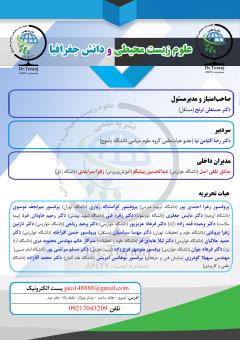بررسی و تحلیل اثرات پیامدهای توربینهای بادی بر محیطزیست
محورهای موضوعی : علوم زیست محیطیفرید منوچهری سربسی 1 , سید مجید کشاورز 2
1 - دانشگاه فنی حرفه ای پسران یاسوج
2 - دانشگاه فنی و حرفه ای استان کهگیلویه و بویراحمد، یاسوج، ایران،
کلید واژه: توربین بادی, زاویه باد, محیطزیست, تحلیل انرژی.,
چکیده مقاله :
کاهش منابع سوخت فسیلی که بخش عظیمی از منابع تولید انرژی بهحساب میآیند و همچنین تأثیرات مصرف اینگونه منابع انرژی باعث بروز مسائل مربوط به آلودگی محیطزیست مانند پدیده گرم شدن جهانی دمای زمین، کاهش ضخامت لایه ازون و از بین بردن منابع طبیعی مانند جنگلها، مراتع و دریاها شده است. در این راستا استفاده از انرژیهای تجدیدپذیر مانند انرژی باد در حال رونق فراوانی است؛ که با بررسی شرایط آب و هوایی هر منطقه میتوان قابلیت استحصال انرژی باد از آن محیط را استخراج کرد. رشد روزافزون صنایع توربینهای بادی در جهان باعث شده که این صنعت یکی از صنایع پیشتاز درزمینهی انرژیهای نو باشد و انتظار میرود که در سالهای آینده این رشد به شکل چشمگیری افزایش یابد. هرچند که نیروگاههای بادی در مقایسه با نیروگاههای سنتی اثرات مخرب کمتری بر روی محیطزیست دارند، ولی تأثیر زیستمحیطی پرههای توربین بادی به چالشی بزرگ تبدیل خواهد شد. دفع و بازیافت پرهها، صدای ایجادشده توسط پرهها، اثرات بصری، کشته شدن پرندگان و حشرات توسط پرهها، اختلالات جوی و آلایندگیهای هنگام ساخت و انتقال و نصب پرهها ازجملهی این مشکلات هستند. بسیاری از این مشکلات با پیشرفت فناوری یا با نصب صحیح نیروگاه رو به کاهشیافته است. هدف از این تحقیق بررسی و ارزیابی اثرات توربینهای بادی بر انسان و محیطزیست میباشد.
The reduction of fossil fuel resources, which are considered a huge part of energy production resources, as well as the effects of the consumption of such energy resources, cause environmental pollution issues such as the phenomenon of global warming of the earth's temperature, the reduction of the thickness of the ozone layer, and the destruction of natural resources such as forests, pastures and The seas have been In this regard, the use of renewable energy such as wind energy is booming; By examining the weather conditions of each region, the ability to extract wind energy from that environment can be extracted. The increasing growth of the wind turbine industry in the world has made this industry one of the leading industries in the field of new energy, and it is expected that this growth will increase significantly in the coming years. Although wind power plants have less destructive effects on the environment compared to traditional power plants, the environmental impact of wind turbine blades will become a big challenge. Disposal and recycling of vanes, noise created by vanes, visual effects, killing of birds and insects by vanes, atmospheric disturbances and pollution during construction, transportation and installation of vanes are among these problems. Many of these problems have been reduced with the advancement of technology or with the correct installation of the power plant. The purpose of this research is to investigate and evaluate the effects of wind turbines on humans and the environment.
1- فضلی، م، مدلسازی و شبیهسازی توربین بادی مجهز با DIFG و STATCOM جهت بررسی عملکرد سیستم در طی خطای شبکه، دانشگاه آزاد اسلامی، تهران جنوب.
http://www.suna.org.ir/fa.
2- Rosa, A. V. da, 2009, Fundamental of renewable energy processes, 2nd edition.
3- http://www.suna.org.ir/suna_content/media/image/2015/11/4180_orig.pdf. [Accessed: 26-Jan-2016].
4- Koroneos, C. Spachos, T. and Moussiopoulos, N. 2003, “Exergy analysis of renewable energy sources,” Renew. energy, pp. 295–310.
5- Baskut, O. Ozgener, O. and Ozgener, L. 2011, “Second law analysis of wind turbine power plants: Cesme, Izmir example,” Energy, 36(5), pp. 2535–2542.
6- Baskut, O. Ozgener, O. and Ozgener, L. 2010, “Effects of meteorological variables on exergetic efficiency of wind turbine power plants,” Renew. Sustain. Energy Rev. 14(9), pp. 3237–3241.
7- Sagol, E. Reggio, M. and Ilinca, A. 2013, “Issues concerning roughness on wind turbine blades,” Renew. Sustain. Energy Rev. pp. 514–525.
8- Khalfallah, M. G. and Koliub, A. M. 2007, “Effect of dust on the performance of wind turbines,” Desalination, 209(3-3), pp. 209–220.
9- Pope, K. Dincer, I. and Naterer, G. F. 2010, “Energy and exergy efficiency comparison of horizontal and vertical axis wind turbines,” Renew. Energy, 35(9), pp. 2102–2113.
10- Mahmoodi, E. Jafari, A. Peter Schaffarczyk, A. Keyhani, A. and Mahmoudi, J. 2013, “A new correlation on the MEXICO experiment using a 3D enhanced blade element momentum technique,” Int. J. Sustain. Energy, (October), pp. 1–13.
11- Bouatem, A. and Mers, A. Al, 2013, “Validation of Chaviaro Poulos and Hansen Stall Delay Model in the Case of Horizontal Axis Wind Turbine Operating in Yaw
12- Howell JA (1997) Avian mortality at rotor swept area equivalents, Altamont Pass and Montezuma Hills, California. Trans. Western Sector Wildlife Society, 33:24-29.
13- Green RH (1979) Sampling designs and statistical methods for environmental biologists. Wiley, New York, NY.
14- Lowther SM, Tyler S (1996) A review of impacts of wind turbines on birds in the UK. Report No. W/13/00426/REP3, Energy Technology Support Unit (ETSU).
15- AWEA (1989) Procedure for measurement of acoustic emissions from wind turbine generator systems. TeirI – standard 2.1, American Wind Energy Association.
16- Rogers AL, Manwell JF (2002) Wind turbine noise issues – A white paper. Renewable Energy Research Laboratory, Centre for Energy Efficiency and Renewable Energy, Department of Mechanical and Industrial Engineering, University of Massachusetts at Amherst, Amherst.
17- Wnager S, Bareib R, Guidati G (1996) Wind turbine noise. Springer Verlag, Berlin.
18- IEA (1994) Expert group study on recommended practices for wind turbine testing and evaluation, 4. acoustic noise emission from wind turbines. International Energy Agency.


